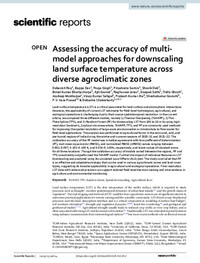Assessing the accuracy of multi-model approaches for downscaling land surface temperature across diverse agroclimatic zones

Authors:
Land surface temperature (LST) is a critical parameter for land surface and atmospheric interactions. However, the applicability of current LST estimates for field-level hydrological, agricultural, and ecological operations is challenging due to their coarse spatiotemporal resolution. In the current article, we compared three different models, namely 1) Thermal Sharpening (TsHARP), 2) Thin Plate Spline (TPS), and 3) Random Forest (RF) for downscaling LST from 100 to 10 m by using high-resolution Sentinel-1,2 optical-microwave data. TsHARP, TPS, and RF are commonly used methods for improving the spatial resolution of large-scale environmental or climate data to finer scales for field-level applications. The analysis was performed at agricultural farms in the semi-arid, arid, and per-humid regions of India during the winter and summer seasons of 2020–21 and 2021–22. The calibration accuracy of the RF model was in better agreement with the coefficient of determination (R2), root mean square error (RMSE), and normalized RMSE (nRMSE) values ranging between 0.961–0.997, 0.103–0.439 K, and 0.034–0.143%, respectively, and lower values of standard errors for all three locations. Though the validation accuracy of models varied between the regions, RF and TPS consistently outperformed the TsHARP model. Further the impact of individual features on LST downscaling was analyzed using Accumulated Local Effects (ALE) plot. The study concluded that RF is an effective and adaptable strategy that can be used in various agroclimatic zones and land cover types, suggesting its broader applicability in agricultural and ecological operations. Finer resolution LST data with enhanced precision can support tailored field-level decision-making and interventions in agriculture and environmental monitoring.
